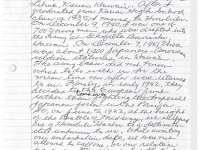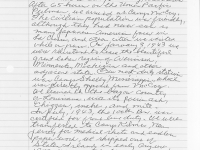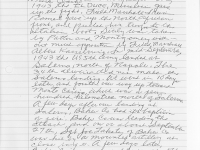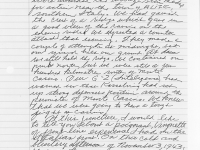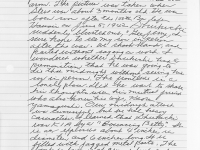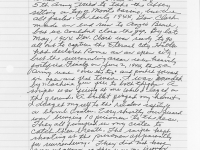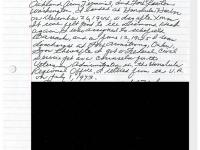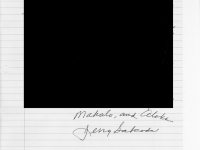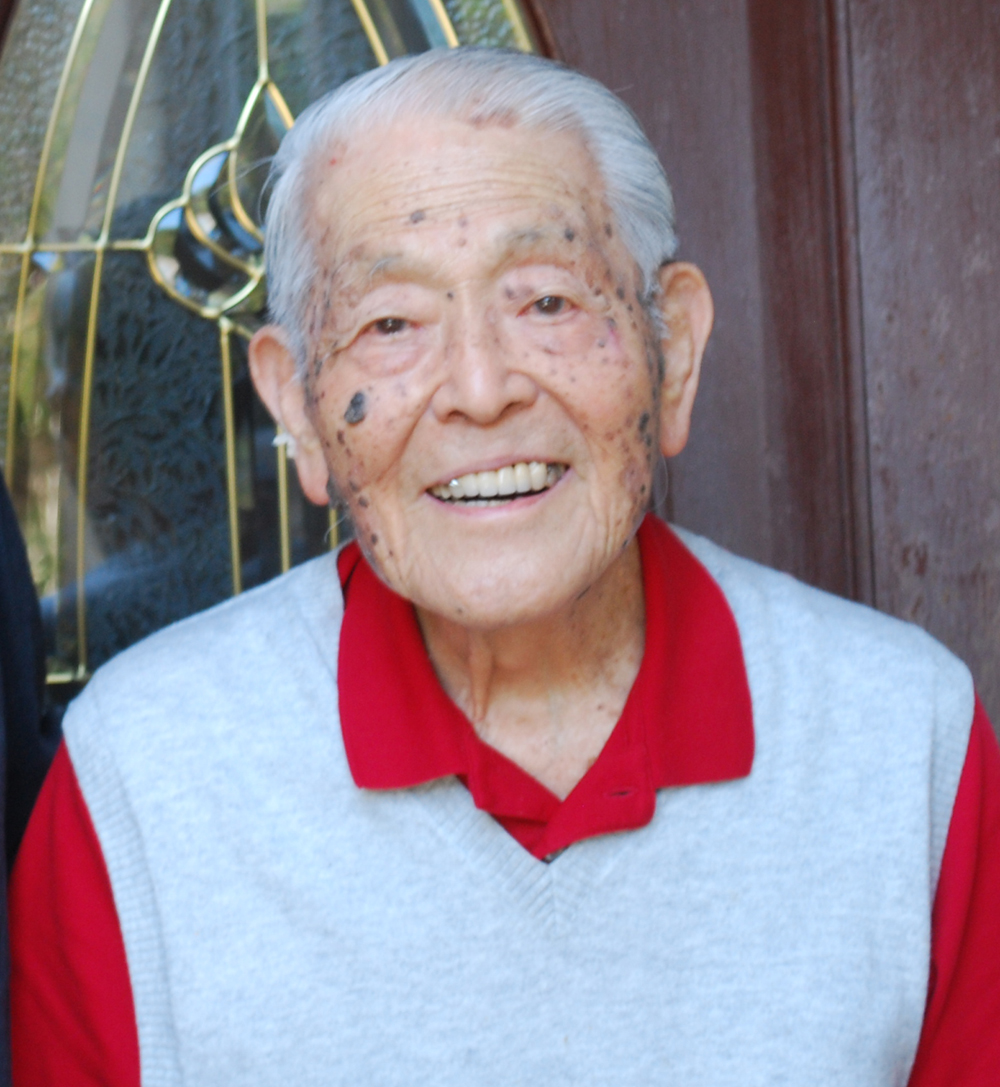 Jerry Sakoda wrote this document in 2013, five years after he and his wife Mabel moved from Honolulu to live in Berkeley, California near one of their daughters.
Jerry Sakoda wrote this document in 2013, five years after he and his wife Mabel moved from Honolulu to live in Berkeley, California near one of their daughters.
Born on the island of Kauai, he was among the men of the first draft in 1940, serving first in the Hawaii National Guard and then what became the 100th Infantry Battalion (Separate). Mr. Sakoda’s narrative includes some of his experiences through basic training in Wisconsin and Mississippi and then combat in Italy until he was wounded in June 1944.
Transcription of Jerry Sakoda’s Memoirs
August 20, 2013.
My name is Jerry H. Sakoda. I was born on December 22, 1916 in Lihue, Kauai, Hawaii. After I graduated from Kauai High School, class of 1935, I moved to Honolulu. On December 9, 1940, I was one of 700 young men who were drafted into the army at Schofield Barracks, Hawaii.
On December 7, 1941, there were about 1400 Japanese American soldiers stationed in Hawaii. The army brass did not know what to do with us. In the mean time our rifles were returned to us. Finally, in early 1942, they decided to send us to the European front rather than fighting the Imperial Japanese forces in the Pacific. So, on June 5, 1942, at the height of the Battle of Midway, we shipped out of Honolulu Harbor to a destination still unknown to us. While awaiting our embarkation date, we were not allowed to call out, or our relatives to call in. My friend, Sgt. Shukichi Sato of Lawai could not call his pregnant wife, and vice-versa. This is a poignant vingnette [sic] of front line experience I had on the battle front I had in Italy, which I will explain later. As soon as we left Hawaii, we received our military designation as the 100th Infantry Battalion (Sep). We were told that we will train at Camp McCoy, Wisconsin. After 65 hours on the Union Pacific Pulman [sic], we arrived at Camp McCoy. The civilian population was friendly, although they had never seen so many Japanese American faces in La Crosse and other cities we visited while on pass. On January 3, 1943 we were reluctant to leave the beautiful great lakes region of Wisconsin, Minnesota, Michigan and other adjacent states. Our next duty station was Camp Shelby, Mississippi, which was directly opposite from McCoy. We trained in the bayou country of Louisiana, with its poison oak, chiggars [sic], snake, and mite.
In July, 1943, the 100th Bn. was certified for front line duty. We were transferred to Camp Kilmer, New Jersey for medical shots and endless paper work. We shipped out of Staten Island in early August, 1943. We were told that our battle front was Italy, and not Europe. In late August, 1943, we landed at Oran, North Africa. At this time, the 100th Bn. was attached to the 34th Division. My military designation was Private of infantry, 1st Platoon, Baker Co, 100th Inf. Bn., (Sep), 133rd Regiment, 34th Division, U.S. 5th Army, Italy, under command of Lt. Gen. Mark Clark. In early September, 1943, the Il Duce, Musolini [sic] gave up the fight. Field Marshall Irwin Romel [sic] gave up the North African front, and pulled his troops to the Italian boot. Sicily was taken by Patton and Montgomery without much opposition by Field Marshall Albert Kasselring [sic]. In mid-September, 1943 the U.S. 5th Army landed at Salerno, north of Napoli. The 34th Division did not make the Salerno landing. We went in 10 days later, and fouth [sic] our way up toward Monte Cassino, which was a few hundred kilometres north of Salerno.
A few days after our landing at Salerno, Baker Co had its baptism of fire. Baker Co was leading the attack, and on or about September 27th, Sgt. Joe Takata of Baker Co was hit by a mounted artillery at close range. A few days later, Baker Co was again the point. The 100th took the town of Benevento, an important rail road center in southern Italy. The Army Stars and Stripes mentioned in an article that with the capture of Benevento, the 100th Bn was the most advanced unit of the 5th Army at that time and date. About mid-October, 1943, all 12 members of our 1st squad were awarded the bronze Star medal for action near the town of Alife, southern Italy. We had gained the crest of a ridge which gave us a good view of the ravine and the enemy side. We expected a counter attack that evening. They made a couple of attempts at midnight, but our squad held our ground. At dawn we still held the ridge. We continued our push north, but we were still a few hundred kilometres south of Monte Casino [sic]. Our G-2 (Inteligence) [sic] had warned us that Kasselring [sic] had set up strong defensive positions around the perimeter of Monte Casino [sic]. We knew we were going to have a tough fight at Casino [sic].
At this juncture, I would like to tell you about a poignant, vingnette [sic] of front line experience I had on the Italian front. On this cold and blustery afternoon of November 3, 1943, the 100th Bn. was poised on the banks of the Volturno River in southern Italy. We had received division orders to launch a midnight attack that night. At dusk, I noticed my friend Sgt Shukichi Sato of Lawai, Kauai coming towards our sector. He was in Fox Co. I knew he had something on his mind because he had a forelon [sic] look on his face. He showed me a picture of his son, Steve, a babe in arms. The picture was taken when Steve was about 3 months old. He was born soon after the 100th Bn left Hawaii on June 5, 1942. Shukichi suddenly blurted out, “Gee,Jerry, I sure hope to see my son in person after the war. We shook hands, and parted without saying a word. I wondered whether Shukichi had a premonition that he was going to die that midnight without seeing his son in person. The front line is a lonely place. Did he want to share his thoughts with his mutual friend who also knew his wife, Kaoru Yamaguchi. Our midnight attack was successful, but we had heavy casualties. I learned that Shukichi was KIA by a “Bouncing Betty.” It is an explosive about 4 inches in diameter, and 6 inches long. It is filled with jagged metal parts. The bomb is buried at ground level and piano wire strung around its perimeter at 2 inches above the ground. When the wire is stepped on, the Bouncing Betty is flipped into the air. At eye level it explodes. It is a vicious weapon. Now I knew Shukichi was not going to see his son in person.
We kept pushing and by late December, 1943, the 34th Division was poised to attack Monte Casino [sic]. All units of the 5th Army tried to take the Abbey sitting on top of Monte Casino [sic], but we all failed. In early 1944, Gen. Clark made an end run to Anzio Beach but we couldn’t close the gap. By late May, 1944 Gen. Clark was ready to go all out to capture the Eternal City. Hitler had declared Rome as an open city, but the surrounding area was heavily fortified. Finally on June 2, 1944, the 5th Army was “over the top” and pushed forward in open and flat terrain. I was wounded by machine gun fire to both thighs. A sniper was firing at me while I layed [sic] on the ground. A bullet pinged my helmet. I dragged myself to the relative safety of a bomb crater. Very shortly our guard was brinigng 10 prisoners to the rear. They all jumped in my crater to catch their breath. The sniper kept shooting at the prisoners apparently for surrendering. They did not have any weapons, so they were my friends. I gave them the 4-pack cigarettes I had in my helmet liner. Later when they were taken away, they shook my hand and thanked me in English. That night I was evacuated to the 300th General U.S. Army Hospital over-looking the beautiful Bay of Napoli. After 5 months of rehabilitation, I was shipped home to Hawaii in late November 1944 via New Port [sic] News, Los Angeles, Oakland Army Terminal and Fort Lawton, Washington. I landed at Honolulu Harbor on December 26, 1944, a day after Xmas. It sure felt good to see Diamond Head again. I was assigned to Schofield Barracks, and on June 12, 1945 I was discharged at Fort Armstrong, Oahu. Soon thereafter I got a Federal Civil Service job as a counselor for the Veterans Administration in the Honolulu Regional Office. I retired from the V.A. on July 1, 1973.
On April 20, 1946 Mabel Uohara of Koloa and I were married in Koloa Union Church.
(Note: The rest of his document is not included as it includes personal details about his family.)
Mahalo, and Aloha
Jerry Sakoda

![Jerry Sakoda [Courtesy of Arlene Sato] Jerry Sakoda [Courtesy of Arlene Sato]](https://www.100thbattalion.org/wp-content/gallery/jerry-sakoda/cache/jerry-sakoda-1x.jpg-nggid045310-ngg0dyn-200x150x100-00f0w010c011r110f110r010t010.jpg)
